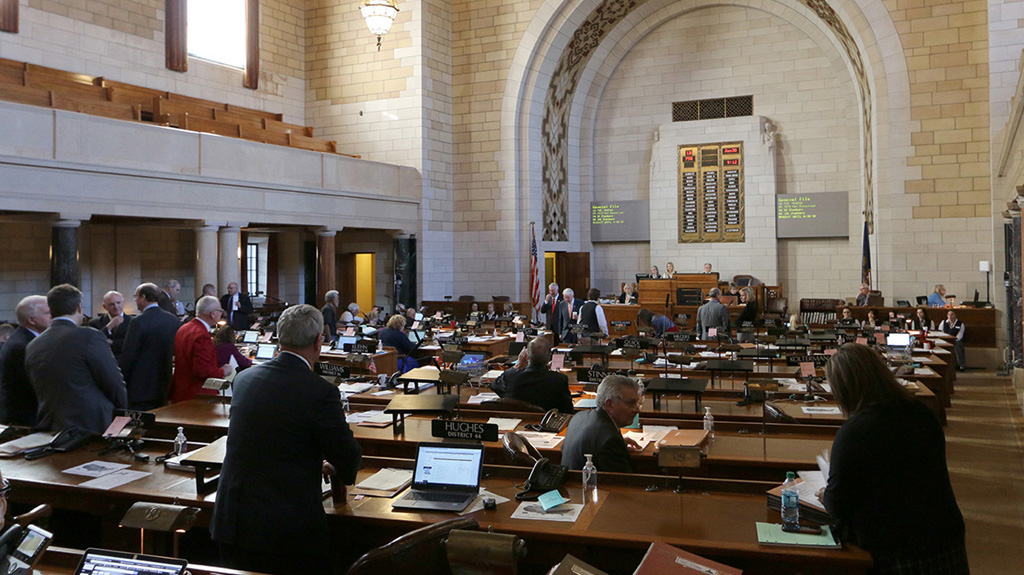Using AI to Improve TV Production Flow: A Media Ecology Perspective
Unlike past advances that primarily enhanced or simplified existing processes, AI has the potential to fundamentally reimagine how content is conceptualized, created and consumed

In the chambers of the Nebraska State Legislature, where accuracy and accessibility of public discourse are paramount, a quiet change has taken place through Legislative Bill 254. This legislation catalyzed the implementation of artificial intelligence (AI)-powered technology that seamlessly integrates closed captioning and real-time translation services for legislative hearings. Achieving an unprecedented 99% accuracy rate, the system has transformed a traditionally resource-intensive process into an efficient, automated solution.
The success of this AI solution in Nebraska's legislative and public-media environment demonstrates a pivotal shift in capability and accessibility. The system adeptly handles complex legislative language, technical terminology and multiple streams simultaneously, not just improving existing processes but fundamentally reimagining how public discourse can be documented and disseminated.
This is just one example of the rapidly evolving landscape of media ecology, where AI is emerging as a transformative force, reshaping not just how content is created but fundamentally altering the ecology of television as a medium. It constitutes a profound shift in the relationship between creators, content and viewers.
This evolution demands a critical examination through the lens of media ecology, considering not only the efficiencies gained but also the broader implications for communication, creativity and culture in an era where the boundaries between human and machine creativity are increasingly blurred.
The Historical Context of Technological Evolution in Television
The television industry has always been shaped by technological advancements, from live broadcasts to recorded shows to the revolution of digital editing. Each shift has not only changed production methods, but has also reshaped viewer expectations and the very operational aspects of televisual communication.
The move from black and white to color television transformed not just the visual experience, but the entire approach to set design, costume choices and visual storytelling. Similarly, the advent of digital editing freed creators from the physical constraints of film cutting, enabling more complex narratives and visual styles that would have been impractical or impossible in earlier eras.
AI represents the next frontier in this ongoing evolution, offering solutions across the entire production workflow while raising important questions about the nature of creativity and authenticity in media creation. Unlike previous technological advances that primarily enhanced or simplified existing processes, AI has the potential to fundamentally reimagine how content is conceptualized, created and consumed. This transformation occurs within a broader context of media convergence where the distinctions between different forms of media are increasingly fluid, and content must be adaptable across multiple platforms and formats.
The professional video industry's #1 source for news, trends and product and tech information. Sign up below.
The Transformation of Pre-Production: Creative Implications and Challenges
In preproduction, AI tools are already transforming traditional processes, introducing both exciting possibilities and complex challenges. Programs analyze vast datasets to suggest plotlines and may even predict audience reactions, accelerating the scriptwriting process.
These tools can process and synthesize enormous amounts of existing content, identifying successful narrative patterns and helping writers avoid common pitfalls. However, this efficiency comes with important considerations about the homogenization of storytelling. When AI systems trained on existing content influence creative decisions, we must question whether this constrains the diversity of narratives or inadvertently reinforces existing tropes and biases.
The role of AI in casting and talent selection also raises intriguing questions about representation and diversity in television. AI systems can analyze audience demographics and preferences to suggest casting choices, but this data-driven approach may inadvertently perpetuate existing biases or prioritize proven formulas over novel choices that could expand representation in media.
The Evolution of Production: Redefining Craftsmanship and Authenticity
The capturing process itself is undergoing a radical transformation through AI-driven camera work and lighting automation. While these advancements offer unprecedented precision and consistency, they also alter the traditional relationship between cinematographers and their craft.
As an AI camera assistant’s perfect movements and framing, we must consider what is gained—and potentially lost—when human intuition is augmented or replaced by algorithmic decision-making. The art of cinematography has long been celebrated for its ability to convey emotion and narrative through subtle choices in framing, movement and lighting. As AI systems become more sophisticated in replicating and optimizing these choices, the nature of visual storytelling expertise may shift from technical mastery to the ability to effectively direct and curate AI-generated options.
In preproduction, AI tools are already transforming traditional processes, introducing both exciting possibilities and complex challenges.”
The integration of virtual sets and augmented reality, facilitated by AI, further blurs the line between the real and the virtual, potentially changing viewers' perception of visual authenticity. This technology enables the creation of complex, fantastic environments that would be impossible or prohibitively expensive to create physically.
However, it also raises questions about the value and meaning of authenticity in television production. As viewers become more aware of the prevalence of AI-enhanced and virtual environments, their relationship with television as a medium may evolve, potentially affecting the suspension of disbelief that has been crucial to television's storytelling power.
Postproduction Revolution: The Changing Nature of Editing and Artistic Expression
Postproduction, traditionally a realm of painstaking human craftsmanship, is being revolutionized by AI-powered tools that automate editing, enhance visual effects and optimize sound design. Platforms now offer AI features that can analyze footage, suggest cuts and even predict viewer engagement.
This automation of creative decisions raises profound questions about the nature of artistic expression in the digital age. As AI handles increasingly sophisticated aspects of post-production, the role of human editors and artists evolves from craftspeople to curators of AI-generated options.
This shift has significant implications for the pacing and rhythm of content. AI editing systems, trained on vast databases of successful shows, may optimize for maximum engagement, potentially creating a new standard for televisual rhythm that prioritizes algorithmic perfection over human intuition or artistic choice. While this could lead to more consistently engaging content, it may also result in a homogenization of editing styles and pacing across different genres and formats.
The impact on visual effects is equally profound. AI-powered tools can now generate complex visual effects with minimal human input, democratizing access to high-quality VFX. This democratization could lead to more visually ambitious productions from smaller studios or independent creators, potentially diversifying the television landscape. However, it also raises questions about the value of human expertise in visual effects creation and the potential loss of the artisanal quality that has characterized much of television's visual evolution.
The Audience-Content Relationship: A New Paradigm
The impact of AI extends beyond the production process to reshape the relationship between content and audience. Predictive analytics powered by AI can forecast viewer reactions before a show is even produced, potentially influencing creative decisions.
This feedback loop between AI-driven audience insights and content creation represents a significant shift in how television communicates with its audience. As content becomes more data-driven, we must consider the implications for storytelling diversity and the potential for AI to either broaden or narrow the scope of televisual expression.
The use of AI in real-time content adaptation presents another frontier in content production. Systems that can analyze viewer engagement and emotional responses in real time could enable the creation of adaptive content that adjusts its narrative, pacing or even ending based on audience reaction. While this level of personalization might enhance viewer engagement, it also raises important questions about the nature of shared cultural experiences and the role of television in shaping collective narratives.
Distribution and Accessibility: Democratization and Its Discontents
In the realm of distribution, AI is transforming how content reaches viewers, with algorithms determining not just technical aspects like compression and encoding, but also personalized content recommendations.
This algorithmic mediation of viewing choices raises important questions about audience autonomy and the filter bubbles that may be created when AI systems curate our media experiences. The democratization of AI-powered production tools may also disrupt traditional gatekeeping structures, potentially allowing for more diverse voices while simultaneously challenging established quality standards.
The ability of AI to optimize content for different platforms and viewing contexts also raises questions about the integrity of the creative vision. When content is automatically adapted for various screen sizes, aspect ratios, and viewing durations, how does this affect the artistic intention and the viewer's experience?
The Future of Television in an AI-Mediated World
As we navigate this AI-driven transformation of content production, it's crucial to maintain a critical perspective that goes beyond technological determinism. We must consider its broader impact on media ecology—the entire environment of human communication and perception.
In this new era, success will likely belong to those who can effectively collaborate with AI systems while maintaining a strong creative vision and understanding of human storytelling. As we move forward, the goal should be to use AI as a means to expand the possibilities of television as a medium for human expression and connection. The true potential of AI in content production may lie not in its ability to replicate or replace human creativity, but in its capacity to augment and inspire it, opening new avenues for storytelling and artistic expression.

Ling Ling Sun is Vice President of Technology for Maryland Public Television and former CTO at Nebraska Public Media from 2014 to 2025.
A respected industry leader, Sun serves as a director on the ATSC Board and is an active member of the NAB Television Technology Committee. Her commitment to public broadcasting is evidenced by her two consecutive terms chairing the PBS Engineering Technology Advisory Committee (ETAC) from 2013 to 2018, alongside her service on the PBS Interconnection Committee. Sun further demonstrated her leadership by heading the NAB Broadcast Engineering & Information Technology (BEIT) Conference Program Committee in both 2023 and 2024. Additionally, she has contributed her expertise to the Technical Panel of the Nebraska Information Technology Commission.
